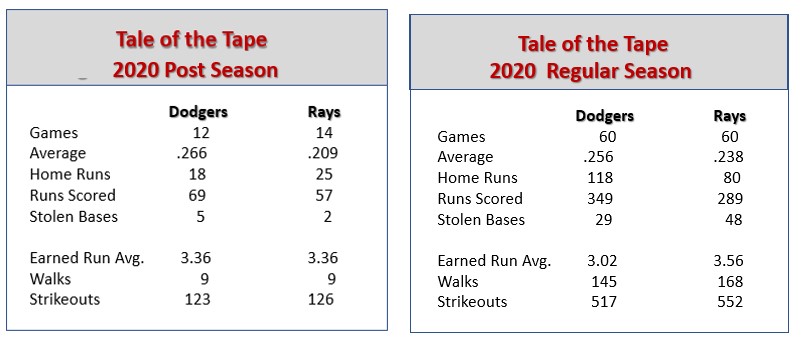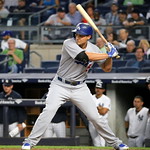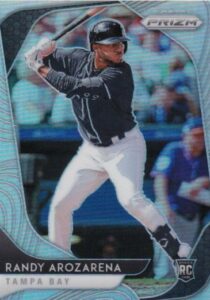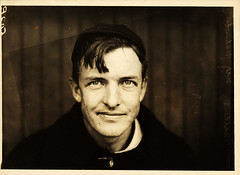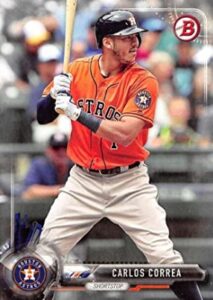With the 2020 World Series Game Four on the horizon, my mind wandered back to past Fall Classics – in particular Game Four of the first World Series I ever took a truly fan-atic interest in. It was 1957 and, as a ten-year-old Milwaukee-born youngster, I was glued to the television (and its black-and-white, grainy portrayal of the national pastime) as my hometown Braves took on the mighty (and heavily favored) Yankees. It was, of course. the Braves’ first trip to the Fall Classic since moving to Milwaukee in 1953 – and the franchise’s’ first World Series appearance since 1948 (only their second since 1914). The Yankees, on the other hand, had appeared in seven of the eight most recent World Series (1949-56), bringing home six World Championships. (Yankee-hating was a popular baseball pastime.)
The Yankees featured future Hall of Famers Mickey Mantle, Whitey Ford and Yogi Berra; while my Braves countered with Hank Aaron, Eddie Mathews and Warren Spahn. (Although, it would turn out that the star of the Series would be Braves’ right-hander “Fidgety” Lew Burdette.)
Lew Burdette Tames the Evil Empire
Lew Burdette pitched three complete games in the 1957 World Series – including shutouts in Games Five and Seven (October 7 and October 10). He put up a 0.67 earned run average in his 27 innings of work.
That 1957 Game Four that I recall so fondly took place at Milwaukee’s County Stadium on October 6. The Braves were down two games-to-one and the Bronx Bombers had trounced them the day before by a 12-3 score behind two home runs by Milwaukee-native Tony Kubek and one by Mantle. Sadly, my Braves had not only given up 12 runs on nine hits, they had walked 11 batters (the Braves had used six pitchers and every one had given up at least one free pass). Now, at the time, my favorite player was Eddie Mathews. (He still is, by the way. True boyhood heroes last.) Happily, Mathews was destined to provide one of my most exciting childhood “big-league memories.”
The game was played on a Sunday and my mother made sure I was ready for the action. There was buttered popcorn (which I was allowed, for this day, to eat on the good couch in front of the TV). There was also A&W Root Beer (an upgrade from the usual Kool Aid).
To make this long story a bit shorter, the Braves went into the ninth inning with a 4-1 lead behind the pitching of Warren Spahn and h0me runs by CF Hank Aaron (Aaron started in CF, with phenom Bob “Hurricane” Hazel in RF) and 1B Frank Torre. Spahn retired Yankee RF Hank Bauer and CF Mickey Mantle to open the ninth and the Braves were one out away from tying the Series. I was in baseball heaven. However, the bubble quickly burst as Spahn gave up singles to C Yogi Berra and SS Gil McDougald and a three-run home run to 1B Elston Howard to tie the contest. The Braves were scoreless in the bottom of the inning – and it was on to extra frames.
With Spahn still on the mound, the Yankees scored in the top of the tenth on a two-out infield single by Tony Kubek and a triple to deep center by Bauer. My heart sank. Little did I know, one of the best moments of my hardball childhood was soon to come. Nippy Jones pinch hit for Spahn to open the Braves’ tenth and was hit by a pitch (the now immortalized “shoe polish-proven” plunking). This was, by the way, Jones’ last-ever MLB trip to the plate. With Felix Mantilla running for Jones, 2B Red Schoendienst sacrificed him to second and SS Johnny Logan doubled him home. That tied the game and brought up my hero – Eddie Mathews – who popped a two-run home run to right on a 2-2 pitch from Bob Grim (appropriate name if you are going to give up a walk-off) to win the game.
Thanks for the Stick, Joe
When Ed Mathews came to the plate in the tenth inning of Game Four of the 1957 World Series, he was not using his own bat. He hit the walk-off home run with teammate Joe Adcock’s stick. Mathews had come into the game zero-for-eight (but with five walks) in the Series and thought a change of lumber might help. He doubled and homered with the borrowed weaponry.
Mathews’ game-winning blast should not have come as a big surprise. The future Hall of Famer was the 1953 NL home run champion at age 21; had hit 222 home runs over his first six MLB seasons; and had just completed his fourth consecutive season with 30 or more round trippers (a streak that would eventually run to nine seasons, with four of those of forty or more long balls). Mathews’1957 stat line was .292-32-94. Over his 17-season career, Mathews hit .271-512-1,453, was an All Star in mine seasons, led the NL in home runs twice and in walks four times.
Seeing Double
Hank Aaron and Eddie Mathews, while Braves teammates, hit more combined home runs than any other pair of teammates in MLB history (863). Second place? Babe Ruth and Lou Gehrig at 859.
Anyway, the memory of Mathews’ walk-off World Series home run, sent me to thinking about other World Series’ games that ended on a walk-off homer – so here’s the list along with my very subjective ranking of significance. (In that ranking I looked at such factors as the inning in which the winning long ball was launched, the number of outs in the inning, the overall course of the game, whether the game was needed to stave off elimination, the creation of “iconic” moments or images and the likelihood of heroics by the particular player involved.)
A bit of a spoiler alert, of the 16 World Series walk-off home run:
- six came in the bottom of the ninth – ten in extra innings;
- the latest of any of the extra-inning walk-off came in the 18th inning;
- six were hit by players now in the Hall of Fame.
- just one came in a Game Seven;
- two came when the winning team was behind on the scoreboard;
- one was hit by a pinch hitter;
- two were hit in cases where the winning team was on the brink of elimination – three if you include the Game Seven walk-off; and
- only two teams have had more than one player hit a World Series walk-off home run – the Yankees (4) and the Dodgers (2).
NUMBER ONE – Bill Mazeroski, Pirates – 10th Inning, 1960 World Series Game Seven– October 13, 1960
If I am going to pick this as my number-one World Series walk-off home run, I better set the stage.
I was thirteen and an avid baseball fan. The television Game of the Week, the radio – especially the radio – and an occasional trip to the ballpark were my tickets to the national past time.
At the time, the Yankees were baseball’s dynasty. Since my birth in 1947, the Bronx Bombers had been to 11 World Series (including the 1960 Series) and had won eight World Championships. The opposing Pirates had last appeared in the Fall Classic in 1927 and last won it in 1925.
Fans from pretty much everywhere but New York had made Yankee-hating a tradition. I was no exception. Milwaukee-born, I was a steadfast Braves fan, still smarting from the Yankees’ 1958 World Series comeback, when they downed my Braves after trailing three games-to-one. The Yankees were in the 1960 Series – and I had an emotional interest in seeing them lose.
Put all of this together and you can see why I looked to the 1960 World Series with excitement – and why I was rooting for the underdog Pirates.
The prognosticators foresaw a Yankee win in five or six games. They pointed out that the Yankees came into the Series with the momentum of a 15-game, season-closing winning streak, while the Pirates lost four of their final seven. They also lauded the Yankees’ post-season experience and heralded the Yankees’ power (the Yankees led the AL with 193 home runs and 746 runs scored, while the Pirates led the NL with 734 runs scored, but had only 120 round trippers). The Yankees’ Game-One starting lineup had belted 152 regular season homers to 98 for the Pirates’ starters. When it came to mound work, things appeared more balanced, maybe even a shade in favor of the Pirates. While the Yankees’ 3.52 ERA was the lowest in the AL, the Pirates’ NL third-best ERA (at 3.49) slightly bettered the Bombers’ mark. The Pirates did have the clear advantage in strikeouts (811-712) and fewest walks allowed (an NL-low of 386 to an AL-worst 609 for the Yankees).
To the surprise of many fans (and analysts), the Series was tied after six games – despite the fact that the Bronx Bombers had outscored the Pirates 46 to 17, outhit them .341 to .232 and out-homered them 8 to 1. (The Yankees had won Game Two 16-3, Game Three 10-0 and Game Six 12-0. The Pirates had prevailed in Game One 6-4, Game Four 3-2 and Game Five 5-2).
Then came Game Seven and Bill Mazeroski’s historic home run.
The Pirates started Vernon Law, 20-9, 3.08 on the season and the winner of Games One and Four. The Yankees countered with Bob Turley, 9-3, 3.27 on the season. Turley had won Game Two, despite giving up 13 hits and three walks in 8 1/3 innings. The Pirates had their top left-handed hitter, Bob Skinner (injured in Game One), back at the number-three spot in the order, while the Yankees were missing Elston Howard (broken finger, Game Six). An upset did seem possible.
Pittsburgh jumped out to a 4-0 lead after two innings, a score that held until the fifth
Casey’s Goodbye
Casey Stengel, despite ten pennants and seven World Series titles in 12 seasons as manager of the Bronx Bombers, was fired by the Yankees five days after the 1960 Game Seven loss to the Pirates.
Law handcuffed the Yankees through four innings, giving up only two singles. In the fifth, Yankee first sacker Moose Skowron made the score 3-1 with a lead-off homer just inside the right field foul pole. Law did not let the round tripper upset him, retiring C Johnny Blanchard, 3B Clete Boyer and P Bobby Shantz (who came on to pitch for New York in the third) in order.
The Yankees closed the gap – and then some – in the top of the sixth. Pesky 2B Bobby Richardson (who already had nine hits in the series) led off with a single to center, and SS Tony Kubek followed with a walk. With the Bombers appearing on the verge of a rally, Murtaugh replaced Law with Elroy Face, his top reliever. Face got RF Roger Maris on a foul pop to Don Hoak at third base, but CF Mickey Mantle followed with a “seeing eye” single up the middle, scoring Richardson. LF Yogi Berra followed with an upper deck home run (like Skowron’s just inside the right field foul pole) to give New York a 5-4 lead.
In the top of the eighth, the Yankees seemed to dash the Pirates’ upset hopes – using a walk, two singles and a double to produce two more runs and a 7-4 lead. Notably, Stengel’s pitching decisions again came into play. He let reliever Bobby Shantz bat with two out and runners at second and third (Boyer and Skowron) and a chance to extend the Yankee lead. Shantz flied out and the press-box managers were quick to point out: 1) the lost scoring opportunity; 2) the fact that Stengel left Shantz in for a sixth inning of work, despite the fact that Shantz had not gone more than four innings in the regular season.
So, that was the situation as the game went into the bottom of the eighth – when the Pirates (and Forbes Field) proved they still has some life left in them. Gino Cimoli pinch hit for Face and stroked a single to right-center. Shantz, who had already induced two double plays, appeared to have worked his magic again, as CF Bill Virdon hit a hard ground ball right at Yankee shortstop Tony Kubek. Just as Kubek was ready to field the ball and begin the sure twin killing, it appeared to hit a pebble (the Yankees had already been critical of the condition of the Forbes Field infield) and ricocheted into Kubek’s throat. Kubek went down, gasping for air and spitting up blood. The end result? Kubek sent to the hospital and replaced by Joe DeMaestri and the Pirates had two on and no outs, instead of none on and two outs.
Pirates’ shortstop Dick Groat took advantage of Kubek’s mishap and lined singled to left, scoring Cimoli. Stengel came to the mound and replaced Shantz with right-hander Jim Coates (despite the fact that left-handed hitting LF Bill Skinner was coming to the plate). The righty-lefty match-up made little difference, as Skinner sacrificed the runners up one base. Next was 1B Rocky Nelson, who flied out to medium right, with the Pirates choosing not to test Roger Maris’ powerful arm. So, two outs, two on and the Yankees still in front 7-5. That brought up the Pirates’ best hitter, RF Roberto Clemente, who had been held hitless in his first three at-bats. Coates made a good pitch, getting Clemente to hit a weak ground ball toward first. A hustling Clemente beat both Coates and Skowron’s throw to the bag, while Virdon scored and Groat moved to third. Now, 7-6 and the Pirates still had life.
Pitching to Contact
The seventh game of the 1960 Series is the only World Series game in which neither team recorded a strikeout. Think about that. A ten-inning game in which 19 runs are scored and not a single batter goes down on strikes. #HowTheGameHasChanged.
That brought up backup catcher Hall Smith, who took a 2-2 Coates’ pitch over the left-field wall for a 9-7 Pittsburgh lead. The Pirates, with only one round tripper in the first six games had homered twice for five runs in Game Seven.
To protect the lead in the ninth, Pirates’ Manager Danny Murtaugh called on starter Bob Friend, who had lost Games Two and Six, giving up seven earned runs in six innings (and had pitched in relief only once all season). Yankee leadoff hitter Bobby Richardson started off the ninth with a single to left. Veteran and former-Pirate Dale Long, pinch hitting for Joe DeMaestri (who had replaced the injured Kubek) singled to right and Friend was gone, replaced by Game Five starter Harvey Haddix. Haddix got Maris on a foul out, but Mantle drove in Richardson with a single to right center. Berra followed with a ground ball down the first base line. Rocky Nelson made a nice backhanded stop, but was out of position for a first-to second-to first, game-ending double play. Nelson took the sure out, stepping on the first base bag and retiring Berra, while Gil McDougald (pinch running for Long) headed toward home. It was at this point that Nelson realized Mantle had not run to second. Mantle, sizing up the situation, was returning to first (with the force at second now off). It was an unorthodox base-running move, but as Mantle dove head first back to the bag (avoiding Nelson’s desperate attempt to tag him), McDougald scored the tying run. Skowron then grounded out to Mazeroski (forcing Mantle) to end the inning in a 9-9 tie.
Stengel, like Murtaugh, was now using starters in relief, bringing Game Four-loser Ralph Terry in to pitch the ninth. Number-eight hitter 2B Bill Mazeroski led off the inning. Terry’s first pitch was a high and inside fastball. The second pitch, another fastball, was in the strike zone and Mazeroski deposited it over the 406-foot marker in left center. Not sure the ball would carry out in the deep part of the park, Mazeroski ran full speed with his head down to first and toward second, before seeing the umpire making the circular home run signal. Mazeroski removed his helmet, waving his way to home plate, where his team mates awaited the first player in major-league history to end the World Series with a Game Seven walk-off home run. This one had it all – a Game Seven, an underdog winner, a see-saw Series and final game and an unlikely hero.
Mazer0ski More Leather than Lumber
Future Hall of Famer Mazeroski was an unlikely “home run hero” – known more for his glove (1960 was his third straight Gold Glove season and he would pick up eight GG in his 17-season MLB career) than his bat (.273-11-64 in 1960 and a career .260 hitter with just 138 regular-season long balls). In that 1960 Fall Classic Game Seven, Mazeroski was batting eighth in the Pirates’ lineup.
Bill Mazeroski played 17 MLB seasons (.260-138-853). He was an All Star in seven seasons and a Gold Glover in five. Despite that .260 career regular-season average, he hit .323-2-5 in 12 post-season games. He led NL second baseman in assists nine times, putouts five times and double plays eight times.
For a look at the entire 1960 World Series and “signs of the times,” click here here.
NUMBER TWO – Max Muncy, Dodgers – 18th inning, 2018 World Series Game Three – October 27, 2018
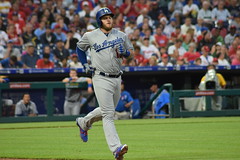
Photo by IDSportsPhoto 
Some may dispute the date of Max Muncy’s walk-off World Series blast. The game actually started on October 26, but ended – with Muncy’s long ball – at approximately 12:40 a.m. October 27. Muncy’s heroics makes number-two on this list by virtue of putting an exclamation mark on the ending of the longest World Series game ever – both in terms of innings (18) and time (seven hours and twenty minutes).
How the Game Had Changed
Game Three of the 2018 World Series involved more total playing time (seven hours and twenty minutes) than the entire 1939 Fall Classic. In the 1939 Series (seven hours and five minutes), the Yankees topped the Reds in four straight games. Game one went to New York 2-1 in one hour and 33 minutes; Game Two ended 4-0 in one hour and 27 minutes; Game three, a 7-3 Yankee win, took two hours and one minute; and the finale, a 7-4 Yankee win in ten innings, took a whopping two hours and four minutes.
The Dodgers struck first on a third-inning home run (off Rick Porcello) by LF Joc Pederson. The Red Sox tied it on an eighth inning homer by starting CF Jackie Bradley, Jr.
Moving About in the Red Sox’ Garden
Red Sox’ starting CF Jackie Bradley Jr. moved to LF in the eighth; back to CF to open the ninth; back to LF with two outs in the ninth; back to CF to open the tenth; back to LF with two outs in the tenth; back to CF to open the eleventh. Starting RF Mookie Betts made an equal number of moves between RF and CF; J.D. Martinez, who started in LF, bounced bounced between LF and RF; and starting 2B Brock Holt also saw time in LF and RF.
Neither team scored again until the top of the 13th inning, when The Red Sox’ Brock Holt opened with a walk (on a 3-2 pitch) off Scott Alexander, stole second and scored on a single (and an Alexander throwing error) by 3B Eduardo Nunez. The Dodgers retied the score in the bottom of the inning which – like the Red Sox half-inning – started with a 3-2 walk. Muncy drew a walk from Nathan Eovaldi, advanced to second on a foul pop out by CF Cody Bellinger and scored on a single by RF Yasiel Puig. The score remained 2-2 until the bottom of the eighteenth, when Muncy led off the inning by launching a 3-2 pitch from Eovaldi over the fence in left-center for the game-winning home run – sending the LA faithful home tired but happy. Muncy finished the game two-for-six, with two runs scored, one RBI and two walks in eight plate appearances. The long ball accounted for his only home run and only RBI in the Series. (He hit .263 with 35 home runs during the regular season). The 18-inning triumph was the Dodgers only win in the Series. Muncy, who started the game at first base, played the final four innings at second base. 
Trivia Tidbits:
- The Dodgers and Red Sox used a World Series’ record 46 players in the game.
- The top four spots in the Red Sox lineup went a combined zero-for-28.
- Dodgers’ pitcher Clayton Kershaw, a three-time Cy Young Award winner, did not take the mound in the game. He was, however, used as a pinch hitter in the 17th inning – lining out to right field.
- There were a record 35 strikeouts in the contest (19 by the Boston hitters).
Max Muncy has played five MLB seasons (2015-16, 2018-20). His career stat line is .236-87-221 in 432 games. In 2018, he hit .251-35-98 (his second consecutive season with 35 home runs).
NUMBER THREE – Kirby Puckett, Minnesota Twins – 11th inning, 1991 World Series, Game Six – October 26, 1991

Photo by compujeramey 
The Twins went into the Sixth Game of the World Series down three games-to two … and CF Kirby Puckett took the must-win contest in hand. In the first inning, Puckett hit an RBI triple and later scored the inning’s second run. Then, in the third frame, he leapt high, glove above the Plexiglas(r) fence in deep left center, to rob Braves’ CF Ron Gant of a two-run home run. In the fifth, after the Braves had tied the game 2-2 in the top of the inning on a home run by 3B Terry Pendleton, a Puckett sacrifice fly brought in Twins’ LF Dan Gladden to regain the lead. The Braves retied it at three in the top of the seventh and that’s where the score stayed until the until Puckett led off the bottom of the twelfth inning with a game-ending home run off Charlie Liebrandt (on a 2-1 pitch). The Twins went on to win Game Seven and the Series 1-0, as Jack Morris threw a ten-inning, complete game shutout in the “winner-takes-all” finale.
The 1991 World Series saw five games decided by one run – three of those in extra innings.
Hall of Famer Kirby Puckett played 12 MLB seasons – retiring at age 35 due to eye issues (glaucoma). He finished with a .318 career average, 207 home run and 1,085 RBI. He was a ten-time All-star, collected 200+ hits in five seasons, leading the AL in safeties four times. He earned one batting title, hitting .300 or better in eight seasons, and earned six Gold Gloves.
Book ‘Em Dano
August 1, 1986 was a big day for Twins fans gathered at the Metrodome – as a pair of future Hall of Famers wrote their names in the record books. In that contest, in which the Twins topped the A’s 10-1, Twins’ starting pitcher Bert Blyleven recorded his 3,000th career strikeout and Twins’ CF Kirby Puckett hit for the cycle. Puckett went four-for-five, with three runs scored and two RBI; while Blyleven pitched a complete-game, two hitter with 15 strikeouts.
Puckett’s home run edges out the next two “iconic” blasts because of its importance in keeping the Twins alive in the Series, the tight nature of the 1991 Fall Classic, the overall way in which Puckett took over the game and the fact the the Twins won Game Seven to take the title.
NUMBER FOUR (tie) – Kirk Gibson, Dodgers – Ninth inning, 1988 World Series Game One – October 15, 1988
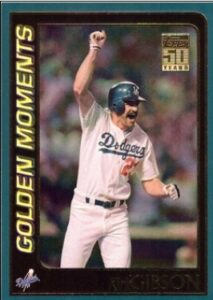 How many times have we seen the iconic video of the injury-hobbled Dodgers’ Kirk Gibson moving gingerly to the plate to pinch hit in the ninth inning of Game One of the 2018 World Series – with the Dodgers trailing 4-3 and down to their last out. How serious were Gibson’s injuries? Well, he was suffering from a severe left hamstring pull and a swollen right knee. The pain was serious enough that Gibson – the key to the Dodgers’ lineup, who would be voted the 1988 National League Most Valuable Player – got only one at bat in the entire 1988 World Series. But it was a big one – a game-winning, walk-off, two-run home run in the bottom of the ninth.
How many times have we seen the iconic video of the injury-hobbled Dodgers’ Kirk Gibson moving gingerly to the plate to pinch hit in the ninth inning of Game One of the 2018 World Series – with the Dodgers trailing 4-3 and down to their last out. How serious were Gibson’s injuries? Well, he was suffering from a severe left hamstring pull and a swollen right knee. The pain was serious enough that Gibson – the key to the Dodgers’ lineup, who would be voted the 1988 National League Most Valuable Player – got only one at bat in the entire 1988 World Series. But it was a big one – a game-winning, walk-off, two-run home run in the bottom of the ninth.
MVP, But Not an All Star
While Kirk Gibson was the 1988 NL Most Valuable Player (.290-25-76, with 31 steals), he was not selected to the All Star Team that season. In fact, in his 17-season MLB career, Gibson never made an All Star Squad.
So, here’s how it went down – or up and out, if you prefer. While the Dodgers were falling behind the favored A’s, Gibson spent a great deal of time not on the field, not even in the dugout, but in the trainer’s room – watching the game on TV and taking physical therapy (although, as the game progressed he did, reportedly, spend a bit of time in the batting cage).
Gibson’s chance to create a lasting World Series memory came, as one might expect, in the bottom of the ninth. The A’s led 4-3 and starter Dave Stewart was relieved by All Star closer Dennis Eckersley, who had the led the majors in saves with 45, while winning four games, losing two and putting up a 2.35 earned run average (a record that would earn him a second-place finish in AL Cy Young Award voting). Eckersley quickly got Dodgers’ catcher Mike Scioscia on a pop out to shortstop and 3B Jeff Hamilton on a called third strike. Dodgers’ manager Tommy Lasorda then brought in Mike Davis to pinch hit for SS Alfredo Griffin. Davis drew a five-pitch free pass from the usual walk-stingy Eckersley, which brought up the pitcher’s spot in the lineup and – to the surprise of fans and broadcaster alike – a limping Kirk Gibson emerged from the dugout to pinch hit.
In what all could see was a painful experience, Gibson fouled off the first two pitches – and the Dodgers were down to their last strike. Gibson fouled off another pitch, took a a ball, fouled off another tough Eckersley offering, took ball two and ball three (while Davis stole second). Then on a 3-2 pitch, Gibson lined a home run to deep right and did a limp-laden, arm-raising and fist-pumping trot around the basses as the Dodger won 5-4. (One of only two World Series gamers featuring a walk-off home run while the winning team was trailing on the scoreboard.) While Gibson would not come to the plate again in the Series, his dramatic long ball set the tone – and the Dodgers topped the favored A;s in five games.
Baseball Roundtable Rant
Dodgers’ pitcher Orel Hershiser won the 1988 World Series MVP Award after giving up just two runs (seven hits, six walks, 17 strikeouts) in two nine-inning, complete-game wins. BBRT always thought one of my favorite players – the energetic Mickey Hatcher – should have at lease been co-MVP of the Series. Hatcher, called upon to play a key role due to Kirk Gibson’s injuries – responded by hitting .368 in the Series and leading all hitter in base hits (7), runs scored (5), home runs (2) and RBI (5). During the 1988 season, Hatcher had hit .293, with one home run and 25 RBI in 88 games.
Kirk Gibson played 17 MLB seasons. He hit .268, with 255 home runs, 870 RBI and 284 stolen bases. He hit 20+ home runs in six seasons and stole 20+ bases in six campaigns. Gibson’s best season was 1985, when he hit .287, with 29 home runs, 97 RBI and thirty stolen bases for the Tigers. The 29 homers and 97 RBI were his career highs. In 21 post-season contests, Gibson hit .282, with seven home runs and 21 RBI. He was MVP of the 1984 ALCS.
NUMBER FOUR (tie) – Carlton Fisk, Red Sox – 12th inning, 1975 World Series Game Six – October 21, 1975
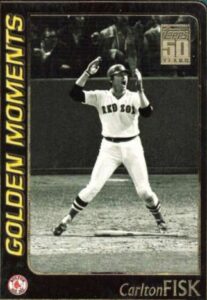 Like Kirk Gibson’s limping, fist-pumping home run trot, Carlton Fisk’s 1975 World Series walk-off homer gave fans a lasting video image – this time of Fisk frantically waving the ball, which hit the Fenway Park left field four pole, fair. It came about in the twelfth inning of Game Six of the 1975 World Series – a game the Red Sox needed to stay alive in the Fall Classic.
Like Kirk Gibson’s limping, fist-pumping home run trot, Carlton Fisk’s 1975 World Series walk-off homer gave fans a lasting video image – this time of Fisk frantically waving the ball, which hit the Fenway Park left field four pole, fair. It came about in the twelfth inning of Game Six of the 1975 World Series – a game the Red Sox needed to stay alive in the Fall Classic.
It had been a tense first five games, with the Reds holding a three games-to-two lead over the Red Sox and three of the first five contests decided by one run (one in extra innings). In Game Six, the Red Sox struck first on a three-run home run by CF Fred Lynn (off Gary Nolan) in the bottom of the first. The Reds came back to tie it with a trio of runs in the top or the fifth – highlighted by a (RF) Ken Griffey Sr. two-run triple and an RBI single by C Johnny Bench (both off Red Sox’ starter Luis Tiant). The Reds then pushed ahead 5-3 on a seventh-inning, two-run double by LF George Foster and grew the lead to 6-3 on a Cesar Geronimo (CF) solo homer in the eighth. The see-saw battle continued as the Red Sox came back to tie it in the bottom of the eighth inning on two-out, three-run homer by pinch hitter Bernie Carbo. (Carbo stayed in to play left field.)
The score was still 6-6 when Fisk led off the bottom of the twelfth against reliever Pat Darcy (the Reds’ eighth pitcher of the game). Fisk who already had a single and two intentional walks (in five plate appearances) hit a 1-0 pitch (at precisely 12:35 a.m. October 22) off the foul pole high above the “Green Monster” in left field – creating a lasting image of him leaping up and down and frantically waving the high fly fair. Fisk’s walk-off led to a Game Seven, which Boston lost 4-3 (the Series had five one-run games). In 2005, the Red Sox named the foul pole the “Fisk Foul Pole” in honor of the blast.
Fisk hit .240 in the series with two home runs, four RBI, five runs scored and seven walks (three intentional).
Rookie of the Year
In 1972, Carlton Fisk was the American League’s first unanimous Rookie of the Year selection. That season, he went .293-22-61 in 131 games and led the AL in triples with nine. Only two MLB catchers have led their league in three-baggers – Fisk in 1972 and Tim McCarver of the Cardinals in 1966.
Hall of Famer Carlton Fisk had a 24-season MLB career (1969, 1971-93) during which he was an 11-time All Star. He hit .269-376-1,330 for his career.
A Hard Day’s Night
On May 8, 1985, Carlton Fisk set a record by catching all 25 innings of his Chicago White Sox’ 7-6 win over the Milwaukee Brewers. Actually, he set the record on May 9, since the game – which took eight hours and six minutes to complete – was suspended at 1:05 a.m. (after 17 innings) and completed before the regularly scheduled May 9 Brewers/White Sox matchup. Fisk went three-for-eleven, with a walk, in the 25-inning game. Notably, while Fisk did not start the regularly slated May 9 game, he he came in as a pinch runner in the bottom of the seventh and caught the final two innings of that contest.
NUMBER SIX – David Freese, Cardinals – 11th inning, 2011 World Series Game Six – October 27, 2011
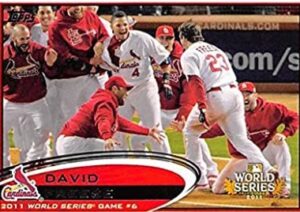 The Cardinals were down three games-to-two to the Rangers, when Game Six of the 2011 Series opened in St. Louis. As they went into the bottom of the ninth, the Redbirds were trailing 7-5 and on the verge of losing the Series. Facing the Rangers’ hard-throwing closer Neftali Feliz, 2B Ryan Theriot went down swinging to open the frame – putting the Cardinals just two outs from elimination. 1B Albert Pujols followed with a double to CF. The next batter, RF Lance Berkman, drew a walk, putting the double play on the board. While he didn’t get the DP, Feliz did get the out, fanning LF Allen Craig to bring up 3B David Freese with the Cardinals one out from losing the Series. Freese got down in the count 1-2 (now the Cards were one strike from going home for the winter) and then laced a triple to right – scoring Pujols and Berkman and tying the game. The Rangers took the lead again with two-run home run by LF Josh Hamilton in the top of the tenth. The Cardinals, however, refused to fold and prolonged their season with two runs on three singles and a walk in the bottom of the inning.
The Cardinals were down three games-to-two to the Rangers, when Game Six of the 2011 Series opened in St. Louis. As they went into the bottom of the ninth, the Redbirds were trailing 7-5 and on the verge of losing the Series. Facing the Rangers’ hard-throwing closer Neftali Feliz, 2B Ryan Theriot went down swinging to open the frame – putting the Cardinals just two outs from elimination. 1B Albert Pujols followed with a double to CF. The next batter, RF Lance Berkman, drew a walk, putting the double play on the board. While he didn’t get the DP, Feliz did get the out, fanning LF Allen Craig to bring up 3B David Freese with the Cardinals one out from losing the Series. Freese got down in the count 1-2 (now the Cards were one strike from going home for the winter) and then laced a triple to right – scoring Pujols and Berkman and tying the game. The Rangers took the lead again with two-run home run by LF Josh Hamilton in the top of the tenth. The Cardinals, however, refused to fold and prolonged their season with two runs on three singles and a walk in the bottom of the inning.
Everybody Gets to Play
Game Six of the 2011 World Series saw the Rangers and Cardinals use a combined 42 players (15 pitchers).
Then, after reliever Jake Westbrook held the Rangers scoreless in the top of the eleventh, David Freese came up big again, hitting a 3-2 pitch from reliever Mark Lowe for a 10-9 Cardinals’ win. The Cardinals went on to take Game Seven by a 6-2 score.
MVP-MVP
David Freese was the MVP in both the 2011 NLCS (when he hit .545-3-9) and the 2011 World Series (.348-1-7), Between Game Two of the 2011 NL Division Series and Game Four of the 2011 World Series, Freese ran up a 13-game, post-season hitting streak.
Freese played 11 MLB seasons, hitting .277-113-535. His best season was 2012, when he went .293-20-79 (career highs in HR and RBI). In 2011, he went .297-10-55 in 97 games.
NUMBER SEVEN – Eddie Mathews – 10th inning, 1957 World Series Game 4 – October 6, 1957
See the opening paragraphs for this one.
NUMBER EIGHT– Tommy Heinrich, Yankees – 9th inning, 1949 World Series Game One – October 5, 1949
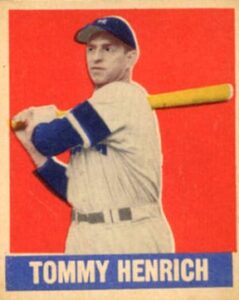 Game One of the 1949 World Series pitted two tough New York rivals – the Yankees and Dodgers. It also showcased stars like Duke Snider, Jackie Robinson, Pee Wee Reese, Carl Furillo, Gil Hodges. Roy Campanella, Phil Rizzuto, Joe DiMaggio and Yogi Berra. And, it featured a pitching duel between Dodgers’ rookie and 17-game winner Don Newcombe and the Yankees ’32-year-old veteran (also 1949 17-game winner) Allie Reynolds. The ultimate star of the game – at Yankee Stadium – would be Yankees ‘1B Tommy Henrich. (Note: Henrich got extra credit in BBRT’s rankings for hitting the first-ever World Series walk-off home run.)
Game One of the 1949 World Series pitted two tough New York rivals – the Yankees and Dodgers. It also showcased stars like Duke Snider, Jackie Robinson, Pee Wee Reese, Carl Furillo, Gil Hodges. Roy Campanella, Phil Rizzuto, Joe DiMaggio and Yogi Berra. And, it featured a pitching duel between Dodgers’ rookie and 17-game winner Don Newcombe and the Yankees ’32-year-old veteran (also 1949 17-game winner) Allie Reynolds. The ultimate star of the game – at Yankee Stadium – would be Yankees ‘1B Tommy Henrich. (Note: Henrich got extra credit in BBRT’s rankings for hitting the first-ever World Series walk-off home run.)
As the game went into the bottom of the ninth, both teams were scoreless and both starting pitchers were still at work. Reynolds had pitched nine frames, giving up just two hits and walking four, while fanning nine. Newcombe may actually have been just a bit more dominating. In eight innings, he had surrendered just four hits, while walking none and fanning eleven.
Tommy Henrich put an end to the contest leading off the bottom of the ninth and taking a 2-0 Newcombe fastball over right-field wall for a 1-0 Yankees win. The Yankees went on to win the Series four games-to-one. Henrich hit .263 in the Series and his walk-off represented his only home run and RBI.
Henrich played in 11 MLB seasons (1937-50, missing three seasons for military service), all for the Yankees. The first-baseman-outfielder hit .282-183-795 and led the American League in triples twice and runs scored once (138 in 1948). He was a five-time All Star. Henrich played in four World Series (1938-41-47-49) and hit one home run in each (.262-4-8 in 21 World Series games).
NUMBER NINE – Dusty Rhodes, New York Giants – 10th inning, 1954 World Series Game One – September 29, 1954
 When fans think about Game One of the 1954 World Series, they generally focus on “The Catch” – Willie Mays’ spectacular eighth-inning, over-the-shoulder, running grab of the Indian’s Vic Wertz’ long drive to deep center field. Mays’ stunning catch and equally spectacular spinning throw back to the infield (holding Indians’ runners on first and second) preserved a 2-2 tie.
When fans think about Game One of the 1954 World Series, they generally focus on “The Catch” – Willie Mays’ spectacular eighth-inning, over-the-shoulder, running grab of the Indian’s Vic Wertz’ long drive to deep center field. Mays’ stunning catch and equally spectacular spinning throw back to the infield (holding Indians’ runners on first and second) preserved a 2-2 tie.
The game stayed knotted at two runs apiece until the bottom of the tenth inning, when Dusty Rhodes was called on to pinch hit for LF Monte Irvin (who was zero-for-three) with runners on first and second and one out. Rhodes hit the first pitch from Indians’ starter and future Hall of Famer Bob Lemon (23-7, 2.72 that season) just over the Polo Grounds’ right-field wall – 257-feet from home plate – giving the Giants a 5-2 win. Rhodes got points in this ranking for knocking the only pinch-hit, World Series, walk-off home run.
Rhodes, who hit .253-54-207 in a seven-season MLB career (1952-57 and 1959) hit .667 in the 1954 Fall Classic (won by the Giants in a sweep), going four-for-six with two home runs and seven RBI. Often coming off the bench. Rhodes played in 100 or more games in only one season. 1954 was his best campaign, he hit .341-15-50 in 82 games (164 at bats) – and .326 as a pinch hitter.
Your Guy in a Pinch
Dusty Rhodes was known as a guy who could come off the bench and deliver a big hit. In fact, 21 percent of his regular-season 1,316 plate appearances came in a pinch-hitting role.
NUMBER TEN – Alex Gonzalez, Marlins – 12th inning, World Series Game Four, October 22, 2003
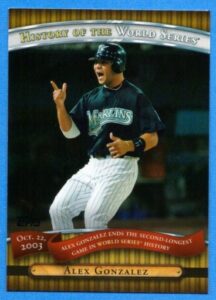 The underdog Marlins came into Game Four of the 2003 World Series trailing the Yankees two games-to-one and facing Roger Clemens.
The underdog Marlins came into Game Four of the 2003 World Series trailing the Yankees two games-to-one and facing Roger Clemens.
How deep was the 2003 Yankee pitching staff? Roger Clemens (17-9 in the regular season) didn’t get a start in the World Series until Game Four. Preceding him were: David Wells; Andy Pettitte and Mike Mussina.
The Marlins jumped on Clemens for three runs in the bottom of the first inning on a two-run home run by RF Miguel Cabrera and a run-scoring single by 1B Derrek Lee. Clemens settled down after that and held the Marlins scoreless over the next six innings. The Marlins, in fact, would be held without a run for 10 straight frames. In the meantime, the Yankees scored one in the top of the second (the only run surrendered by Marlins’ starter Carl Pavano over eight innings) and two in the top of the ninth on a two-strike (3-2 count), two-run triple by pinch hitter Ruben Sierra (off Marlins’ closer Ugueth Urbina).
The Marlins’ escaped a two-on, nobody-out Yankee threat in the top of the eleventh and, as the game went into the bottom of the twelfth, it was still 3-3. Gonzalez led of the Marlins’ half of the twelfth inning, by going yard on a 3-2 from Jeff Weaver. That win seemed to turn the Series on end – as the Marlins won the next two games to take home the championship.
Gonzalez played 16 MLB seasons, hitting .245-157-690. He was an All Star just once, in his first full MLB season (age 22), when he hit .277-14-59 in 136 games. His walk-off homer in the World Series was his only long ball in 83 post-seasons at bats (24 games).
NUMBER-ELEVEN – Joe Carter, Blue Jays – 9th inning, 1993 World Series, Game Six – October 23, 1993
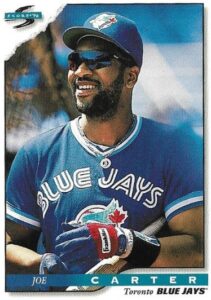 Joe Carter’s World Series’ walk-off is one of only two in which the home team was trailing (rather than tied) at the time of the blast (and would have finished higher on this list if it had come late in extra innings or if the Blue Jays had needed the win to stay alive in the Series). Carter’s Blue Jays, up three games-to-two, looked to have the game in hand early – leading the Phillies 5-1 after six innings. The Phillies, however, shocked the home crowd with a five-run top the seventh. Jays’ starter Dave Stewart, who had given up just one run over the first six innings, walked SS Kevin Stocker (in a ten-pitch at bat) to start the inning, then gave up a single to 2B Mickey Morandini (the number-nine hitter) and a three-run home run to CF Lenny Dykstra. That brought on reliever Danny Cox, who got just one out, while surrendering three singles and a walk – leaving with one run already in and the bases loaded. Next to the mound was Al Leiter, who gave up a sacrifice fly before recording the final out of the frame. Suddenly, a 5-1 Blue Jays’ advantage had turned to 6-5 Phillies.
Joe Carter’s World Series’ walk-off is one of only two in which the home team was trailing (rather than tied) at the time of the blast (and would have finished higher on this list if it had come late in extra innings or if the Blue Jays had needed the win to stay alive in the Series). Carter’s Blue Jays, up three games-to-two, looked to have the game in hand early – leading the Phillies 5-1 after six innings. The Phillies, however, shocked the home crowd with a five-run top the seventh. Jays’ starter Dave Stewart, who had given up just one run over the first six innings, walked SS Kevin Stocker (in a ten-pitch at bat) to start the inning, then gave up a single to 2B Mickey Morandini (the number-nine hitter) and a three-run home run to CF Lenny Dykstra. That brought on reliever Danny Cox, who got just one out, while surrendering three singles and a walk – leaving with one run already in and the bases loaded. Next to the mound was Al Leiter, who gave up a sacrifice fly before recording the final out of the frame. Suddenly, a 5-1 Blue Jays’ advantage had turned to 6-5 Phillies.
It stayed that way until the bottom of the ninth, when Phillies’ closer Mitch Williams walked Blue Jays’ LF Rickey Henderson on four pitches to start the inning. CF Devon White then flied to left for the first out. DH Paul Molitor followed with a single, which set up RF Carter’s game-winning three-run home run – giving the Blue Jays a four game-to-two Series win – and creating a memory that lives on in Blue Jays’ lore.
Power and Speed
Joe Carter had six seasons of 30 or more home runs and six campaign of 20 or more stolen bases. In 1987, he had a 30-30 season – .264-32-106, with 31 steals.
Carter payed 16 MLB seasons, going .259-396-1,445, with 231 stolen bases. He was a five-time All Star and ten times drove in 100+ runs. In 1993, he hit .254, with 33 home runs and 121 RBI in the regular season and .280-2-9 in the World Series.
NUMBER TWELVE – Derek Jeter, Yankees – 10th inning, 2001 World Series Game Four – October 31, 2001
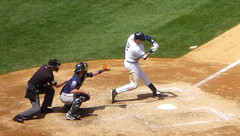
Photo by Pat Guiney 
The Yankees came into Game Four of the 2001 World Series down two games-to-one to the Diamondbacks – and facing Curt Schilling, who had gone 22-6 and fanned 293 batters in the regular season and had held the Yankees to two hits and one run in seven innings (picking up the win) in Game One.
The Yankees jumped out on top 1-0 in the bottom of the third on a home run by LF Shane Spencer. The Diamondbacks came right back with a home run by 1B Mark Grace (off Orlando Hernandez) in the top of the fourth and took a two-run lead in the top of the eighth on a single, double and fielder’s choice. The Bronx Bombers, in danger of falling behind three games-to-one, tied it on a two-run home run by 1B Tino Martinez (off Byung-Hyun Kim) with two outs in the bottom of the ninth.
Mariano Rivera pitched a 1-2-3 top of the tenth – and Derek Jeter ended it by taking Kim deep on a 3-2 pitch with two out in the bottom of the inning. (The Diamondbacks eventually won the Series four games-to-three.)
Two decades of Safeties
Derek Jeter’s 3,465 MLB hits are sixth all time.
Hall of Famer Derek Jeter played 20 MLB seasons – going .310-260-1,311, with 358 steals. He was a 14-time All Star and the 1996 AL Rookie of the Year. Jeter scored 100 or more runs in 13 seasons, hit .300 or better 12 times, had 200+ hits in eight seasons and 20+ stolen bases in eight campaigns. He was also a five-time Gold Glover.
October Baseball in His Blood
Derek Jeter leads MLB in post-season games played (158), base hits (200), runs scored (111), doubles (32), triples (5-tied) and total bases (302).
NUMBER THIRTEEN – Scott Podsednik, White Sox – 9th inning World Series Game Two – October 23, 2005
While White Sox’ LF Scott Podsednik’s home run didn’t come in extra innings or in a Series-winning or Series-extending game, it did come as a surprise. That’s because during the 2005 season, Podsednik had gone without a single round tripper (507 at bats). The White Sox, who had topped the (then) National League Astros 5-3 in Game One of the Series, carried a 6-4 lead into the ninth inning of Game Two. They brought in closer Bobby Jenks to seal the deal, but a pair of singles and a walk (and two outs) later, Jenks was gone and the game was tied. The Astros brought in Brad Lidge in the bottom of the inning to keep it there. After getting number-nine hitter SS Juan Uribe to fly out, Lidge gave up a surprising home run to the power-starved Podsednik to end the contests and send the White Sox on the way to a four-game sweep. Podsednik by the way, had put up a .290 average and stolen 59 bases during the regular season.
Dangerous on the Base Paths
In the four seasons from 2003 through 2006, Scott Podsednik stole 212 bases, including a league-leading 70 in 2004.
Podsednik played 11 MLB seasons, hitting .281-42-812 with 309 stolen bases. Despite not showing a lot of regular-season power, Podsednik’s 14 post-season hits (in 12 games) included one double, three triples and two home runs. His post-season slugging percentage was .551, compared to a regular-season career slugging percentage of .379.
NUMBER FOURTEEN – Mickey Mantle, Yankees – 9th inning, 1964 World Series, Game Three – October 10, 1964
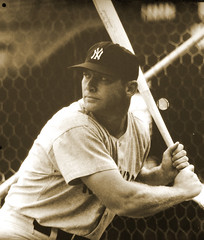
Photo by Tony Fischer Photography 
You had to expect Mickey Mantle to appear on this list. After all, he hit a record 18 World Series home runs in his career. His only walk-off Fall Classic long ball came against the Cardinals in Game Three of the 1964 Series. The Cards and Yankees had split the first two contests in a couple of lopsided slugfests. The Cards won Game One 9-5, while the Yankees prevailed 8-3 in Game Two. Moving to New York for Game Three, a pair of 18-game winners (Curt Simmons of the Cards and Jim Bouton of the Yankees) held the opposing offenses in check – with the game tied 1-1 after eight innings. Simmons had given up one run on four hits – in the second inning, 3B Clete Boyer had plated C Elston Howard with an RBI single. Bouton have given up one run on six hits, as Simmons helped his own cause, driving in C Tim McCarver with a fifth-inning single.
In the top of the ninth, Bouton pitched around an error by SS Phil Linz on a McCarver grounder and a walk to pinch hitter Carl Warwick – holding the score at 1-1. Barney Schulz came on in relief of Simmons and Mantle hit his first offering for a walk-off homer to right. The Cardinals went on to win the Series four games-to-three, despite Mantle hitting .333, with three home runs and 8 RBI.
The World Series Belong to Mick
Mickey Mantle, who played in 65 World Series Games, holds the career records for World Series walks (43); extra-base hits (26); home runs (18); runs batted in (40); runs scored (42); total bases (123); and strikeouts (54). He hit .257 in Fall Classic play.
The Hall of Famer played in 18 MLB seasons and was an All Star in all but two of them. (1951 & 1956). He was a three-time AL MVP and four-time AL home run leader. Hi collected 2,415 career hits (.298 average); 536 home runs; and 1,509 RBI. Mantle won the AL Triple Crown in 1956 with a .353-52-130 line and was a three-time AL Most Valuable Player.
NUMBER FIFTEEN – Mark McGwire, A’s – 9th inning, 1988 World Series, Game 3 – October 18, 1988
 The Oakland A’s went into the 1988 World Series as favorites, but ended up losing to the Dodgers four games-to-one. Mark McGwire’s walk-off home run in Game Three gave the A’s their only victory.
The Oakland A’s went into the 1988 World Series as favorites, but ended up losing to the Dodgers four games-to-one. Mark McGwire’s walk-off home run in Game Three gave the A’s their only victory.
With the low final score (2-1), you might expect that the game was a classic pitching duel between the Dodgers’ John Tudor (10-8, 2.32 during the season) and A’s Bob Welch (17-9, 3.64). Not the case, as Tudor was gone after just 1 1/3 innings – pulled due to an elbow injury after retiring the first four batters he faced. Welch fared a bit better giving up just one run in the first five innings– but having thrown a lot of pitches under stress (four hits and two walks over the first five frames). Welch was pulled after the sixth inning started with the A’s loading the bases (double, single, walk) with no outs.
The bullpens pretty much took care of business in this one, with the score knotted at one run apiece after eight innings. In the top of the ninth, the A’s Rick Honeycutt set the Dodgers down in order (he retired six straight batters in his two-inning stint). Jay Howell came on for the Dodgers in the bottom of the inning and, after getting Jose Canseco to pop out, gave up a game-ending home run to McGwire on a 2-2 pitch (in a tough eight-pitch at bat).
The 1988 World Series is the only Fall Classic with two games ending on walk-off home runs – Games One and Three.
McGwire’s walk-off home run in Game Three of the 1988 World Series was his only hit in the Series (17 at bats).
In 1988, Mark McGwire hit .260-32-99 – a season after a .289-49-118 rookie campaign (and the American League Rookie of the Year Award). McGwire played 16 MLB seasons, was a 12-time All Star and four-time league home run champ. His final MLB stat line was .263-583-1,414. In 1998, McGwire hit 70 round trippers. He followed that up with 65 long balls in 1999. McGwire is one of just three players with four seasons of fifty or more home runs (McGwire, Babe Ruth, Sammy Sosa).
On the Move, In the Groove
In 1997, Mark McGwire led all of M LB with 58 home runs, but did not win a league home run championship. He hit 34 home runs in 105 games for the A’s, before being traded to the Cardinals, for whom he hit 24 home runs in 51 contests.
NUMBER SIXTEEN – Chad Curtis, Yankees – 10th inning, 1999 World Series Game Three- October 26, 1999
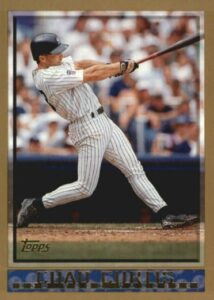 The Yankees were already up two games-to-none on the Braves going into Game Three of the 1999 World Series, but the Braves came out of the gate hot, building a 5-1 lead over the first four innings. The Yankees, however, tightened up on the mound (getting 6 1/3 scoreless innings from three relievers) and slowly chipped away. LF Chad Curtis got one back with a home run off Tom Glavine in the fifth. 1B Tino Martinez added a solo shot off Glavine in the seventh. And 2B Chuck Knoblauch hit a two-run homer in the eighth. Not so suddenly, the game was tied. Both teams were scoreless in the ninth to send the contest into extra innings. The Braves pulled out all the stops in the top of the tenth, using a trio of pinch hitters (among four batters) – Ozzie Guillen, Ryan Klesko and Greg Myers, but did not score. Curtis led of the bottom of the tenth with his second home run of the game – joining the list of players with walk-off World Series dingers.
The Yankees were already up two games-to-none on the Braves going into Game Three of the 1999 World Series, but the Braves came out of the gate hot, building a 5-1 lead over the first four innings. The Yankees, however, tightened up on the mound (getting 6 1/3 scoreless innings from three relievers) and slowly chipped away. LF Chad Curtis got one back with a home run off Tom Glavine in the fifth. 1B Tino Martinez added a solo shot off Glavine in the seventh. And 2B Chuck Knoblauch hit a two-run homer in the eighth. Not so suddenly, the game was tied. Both teams were scoreless in the ninth to send the contest into extra innings. The Braves pulled out all the stops in the top of the tenth, using a trio of pinch hitters (among four batters) – Ozzie Guillen, Ryan Klesko and Greg Myers, but did not score. Curtis led of the bottom of the tenth with his second home run of the game – joining the list of players with walk-off World Series dingers.
Curtis played 10 MLB seasons, hitting .264-101-461, with 212 stolen bases. He stole 20+ bases five times and hit a career-high 21 home runs for the Tigers in 1995.
Chad Curtis stole 91 bases in his first two MLB season (1992-93) with the Angels.
Primary Resource: Baseball-Reference.com
 Baseball Roundtable is on the Feedspot list of the Top 100 Baseball Blogs. To see the full list, click here.
Baseball Roundtable is on the Feedspot list of the Top 100 Baseball Blogs. To see the full list, click here.
I tweet baseball @DavidBBRT
Follow/Like Baseball Roundtable’s Facebook Page here. More baseball commentary; blog post notifications; PRIZES.
Member: Society for American Baseball Research (SABR); Negro Leagues Baseball Museum; The Baseball Reliquary


